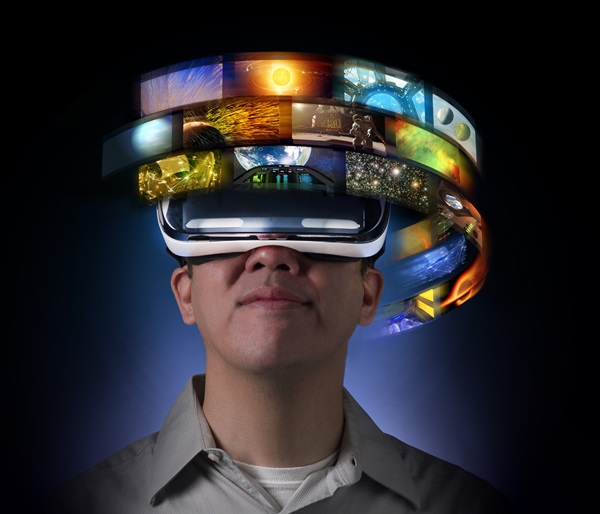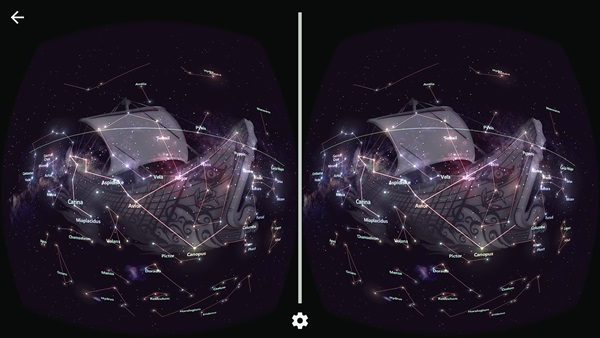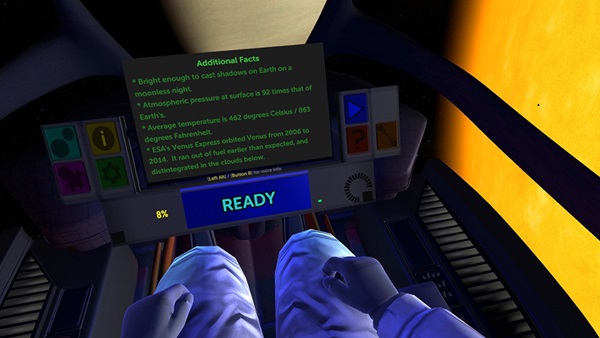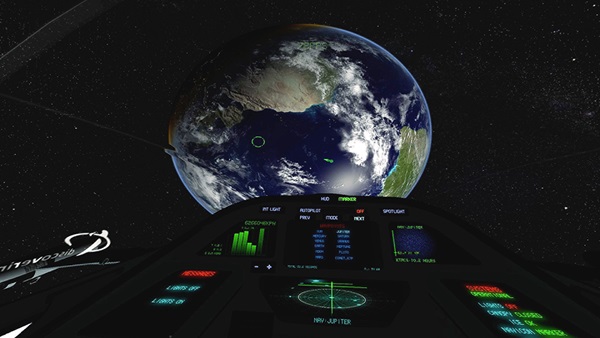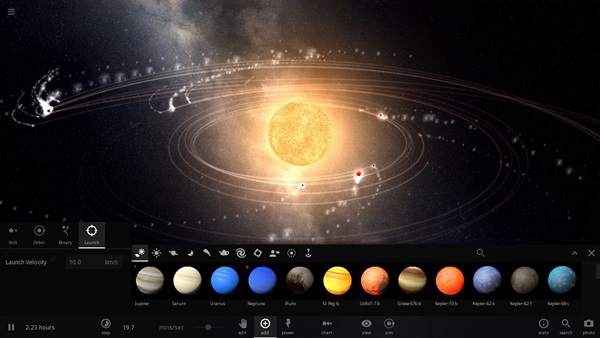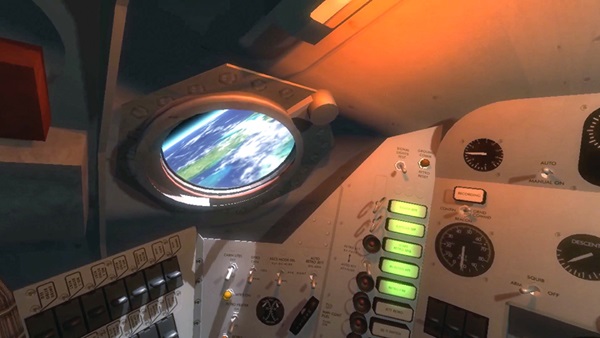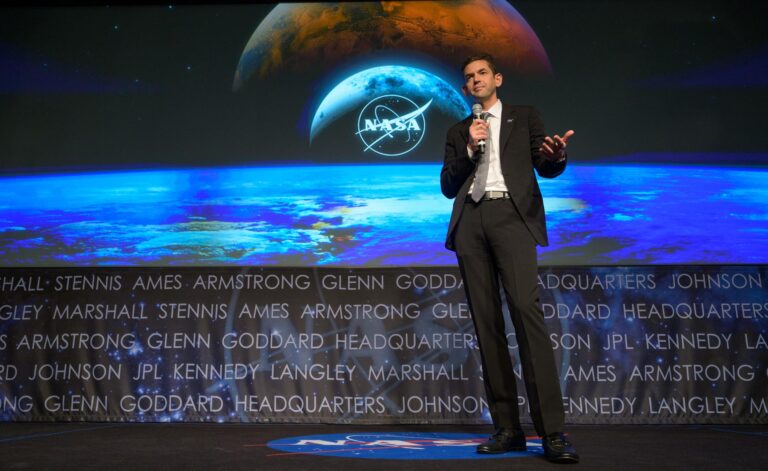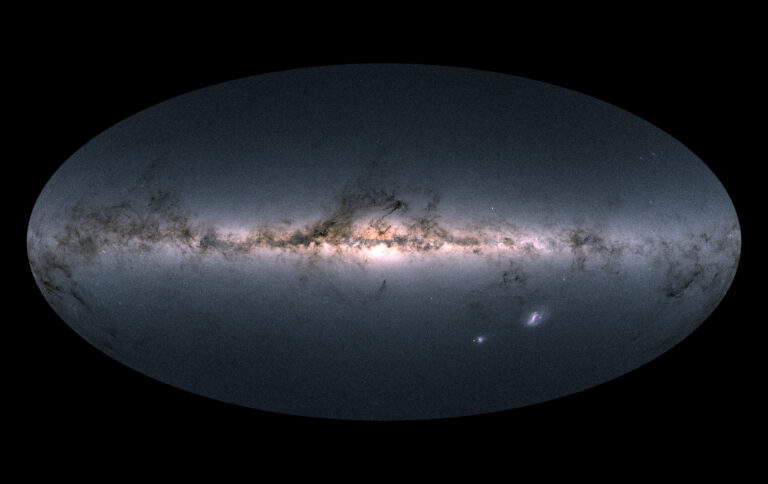Key Takeaways:
Virtual reality is finally entering prime time. And that’s good news for astronomy junkies.
You can explore Mars, manipulate the solar system, experiment with orbital dynamics, and land on the Moon, all from the comfort of your home.
To understand just what virtual reality is, let’s distinguish between the two different ideas behind combining the digital and the real world. Augmented reality (AR) consists of adding digital components to the real world. Virtual reality (VR), a more immersive approach, removes all constraints of the physical world and places you directly into a computer simulation. VR allows you to float among the stars, create or destroy virtual solar systems, or finally get a taste of that childhood dream — becoming an astronaut.
Just how does VR work for the enthusiastic amateur astronomer? VR can be broken down into a couple of areas: mobile VR and high-end VR.
Examples of mobile VR include Google Cardboard, which is available on both Android and iOS platforms. It requires only a semi-modern phone capable of meeting the hardware requirements, and a headset (which costs anywhere from free to $100 or more) responsible for holding the phone and allowing for interaction. Another popular product, Samsung’s Gear VR, developed in conjunction with Oculus, is tailored to work with certain Samsung phones and is more advanced than the Google Cardboard (though not quite to Oculus levels.)
On the other end of the experience scale, we find headsets that require the user be tethered to a powerful personal computer or gaming console. As of this writing, 2016 has already seen the introduction of the Oculus Rift and the HTC Vive, VR units designed for personal computers.
The two are similar in form and function. The Rift is slightly more comfortable and polished, but the Vive currently ships with tracked motion controllers (wands) that allow you to directly manipulate your virtual environment. The Oculus version of those wands, Touch, was unveiled in October 2016. After Touch ships, the systems will ultimately offer similar experiences, and for the most part be cross compatible.
At this point, most VR experiences do not require hand controllers and are accessible via a game pad. With Rift pricing at $599 and Vive at $799, the cost of entry is steep, although the Vive price does include the controllers. After Oculus releases Touch, the systems should cost about the same. Both headsets are readily available, but you’ll need a powerful Windows-based computer system to run them (Apple Macintosh systems aren’t supported). The minimum specs include a modern Intel i5 Core Processor, 8 GB of RAM and a GTX 970 graphics card. Several manufacturers sell VR-ready PCs, typically costing north of $900.
Now that we have a basic understanding of what’s involved, let’s take a look at some experiences available for amateur astronomers.
Mobile VR
The top two choices are the Google Cardboard, which works for Android and iPhone devices, and Gear VR, which is specific to Samsung devices.
Mobile/desktop
Some overlap exists between mobile and desktop VR. Generally where they exist on both platforms you’ll find a smoother, higher definition experience with the pricier units and perhaps some added features to boot.
There are a few software outlets. Oculus Home is only for use with a VR headset. Steam is an online software distribution platform available for download via the web. WEARVR, www.theriftarcade.com and itch.io are online stores designed for VR software. If software is in “early access,” it is still under development, and while complete enough for use, it is actively undergoing changes, both to add new content and eradicate bugs. Note that in some cases compatibility for a particular title may require running some extra software.
Available on: Google Play
Developer: PYOPYO Studio
Price: Free
StarTracker VR is a “mobile planetarium” that features the familiar spots in our solar system — the Sun, planets, dwarf planets, and natural satellites — along with 8,000 stars, 88 constellations, and 100 deep-sky objects, with the
location set by GPS to help you find out what will be above you that night.
It’s similar to many programs that allow skytracking, but by moving with your head, it may make finding out what that object is much easier.
Available on: Oculus Home, Steam, www.wearvr.com
Developer: DrashVR LLC
Price: $7.99
This major upgrade to the original is a must-have experience, featuring a tour of the solar system and selected extrasolar giants. I found VR an immense benefit when trying to wrap my mind around the scale of the universe. You can think of this as a museum exhibit crossed with a thrill ride.
For those of you who remember Powers of Ten, which scaled bit-by-bit through the universe from humanity to infinity, this is a more modern version of that film.
Available on: Oculus Home, Google Play, itch.io
Developer: DrashVR LLC
Price: $1.99
Mars Is a Real Place is described as a “slideshow of more than 50 high-resolution stereoscopic 3-D images of martian landscapes, set to music with supplementary information supplied.”
Look to your left, and you’ll find the top-down stereoscopic image; look right, and you’ll see a map of Mars showing where the current image is located. Look behind you, and you’ll see an orbital view of Mars.
Available on: www.theriftarcade.com
Developer: Simon Phillips
Price: $13.99
This self-guided exploration of our solar system places you in your own spacecraft. Currently Earth, the Moon, Mars, and Titan are modeled surface-to-orbit, and more is expected to come. If you found the idea behind Titans of Space
to your liking but prefer a leisurely investigation and exploration of the planets, this is the one to pick up. It’s not quite as scientifically accurate, but Discovering>Space2 is graphically impressive and can inspire a profound sense of discovery.
Available on: Steam, Oculus, www.wearvr.com
Developer: DrashVR LLC
Price: Free; $2.99 for an extra 50 minutes of narration
This on-rails (that is, the user doesn’t control movement in three dimensions) guided tour of selected planets and stars was developed to give the viewer a sense of scale of just what’s out there.
You may have seen one of the many stellar size comparison graphics or videos floating on the internet; this is a much more polished version of that.
It’s really hard to emphasize just how much difference VR presence makes in truly getting a feeling for the actual size of some of the objects out there in the universe.
On a personal note, Titans of Space was my first astronomy virtual-reality experience, and I found it both awe inspiring and educational.
Available on: Oculus Home, Steam
Developer: Immersive VR Education Ltd.
Price: $9.69
This new type of documentary allows you to experience the highlights of the Apollo 11 flight and landing as if you were actually alongside the men who flew to the Moon in 1969. It features a cinematic mode for those who simply wish to sit back and watch, and an interactive mode, which allows you to fly the command module and land the lunar lander, explore the Moon’s surface, and deploy scientific experiments.
In development for years before the release of the consumer versions of VR headsets, Apollo 11 VR Experience has been known to bring tears to the eyes of many individuals, myself included. Not only is the imagery spot on, but it includes narration and commentary from the astronauts themselves. If you have any interest in space flight, get this one.
Available on: Steam
Developer: Dan Dixon
Price: $24.99
This physics-based space simulator allows you to create, destroy, and generally interact with the universe. It requires tracked motion controllers, so it’s compatible only with the Vive, but support for Oculus Rift is in the works. Whether making Jupiter swell to 80 times its current size or colliding two neutron stars, this is the experience you’re looking for.
These technologies allow us
to go places and experience things once impossible, or restricted to an elite few. While VR is still in its infancy, we appear to be on the verge of a paradigm shift for both education and entertainment. Imagine learning about Pluto while standing on its surface, or studying history by experiencing it. I can’t wait to see what the next generation of virtual reality brings.
Available on: www.goforlaunch.co.uk
Developer: Joe Chisholm
Price: In development; demo is available for free
This advanced space-flight simulation is designed to cover the early years of the U.S. manned space flight program.
Joe Chisholm’s focus is on “re-creating the most historically and technically accurate simulation of the Mercury spacecraft.” He plans to re-create seven spacecraft inside and out, accurate models of the control rooms, a detailed model of Earth from orbit, accurate constellations, and more.
A free early demo is available. It places you in the cockpit of Alan Shepard’s Freedom 7 during his May 5, 1961, flight. As an early backer of the program through Indiegogo, I am eagerly looking forward to the finished version in the next year or so. The demo is a must-have experience for anyone interested in the history of manned space flight.

